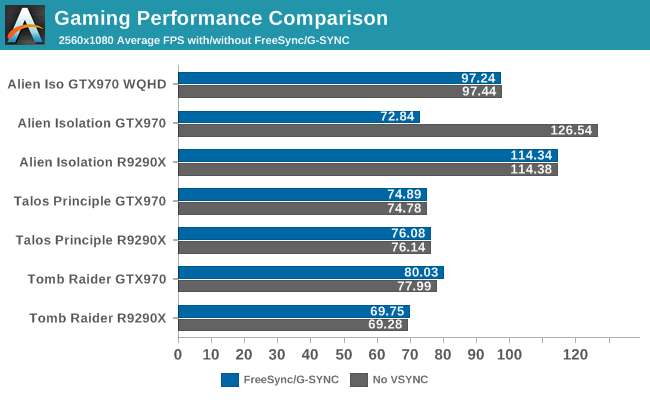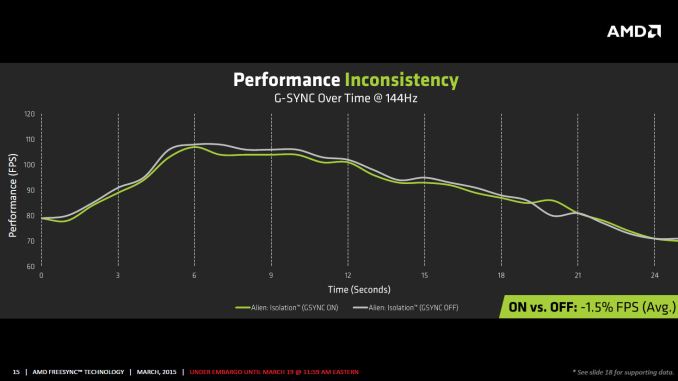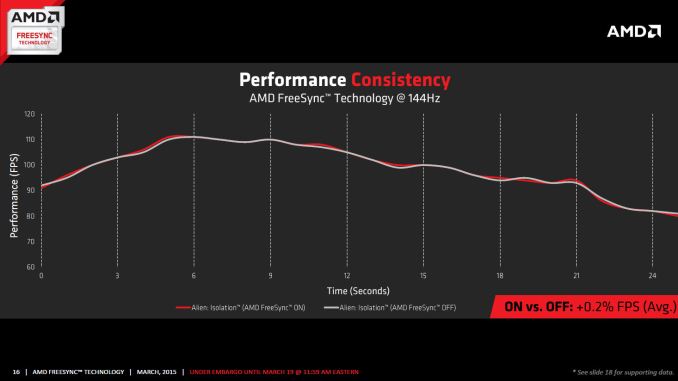The AMD FreeSync Review
by Jarred Walton on March 19, 2015 12:00 PM ESTFreeSync vs. G-SYNC Performance
One item that piqued our interest during AMD’s presentation was a claim that there’s a performance hit with G-SYNC but none with FreeSync. NVIDIA has said as much in the past, though they also noted at the time that they were "working on eliminating the polling entirely" so things may have changed, but even so the difference was generally quite small – less than 3%, or basically not something you would notice without capturing frame rates. AMD did some testing however and presented the following two slides:
It’s probably safe to say that AMD is splitting hairs when they show a 1.5% performance drop in one specific scenario compared to a 0.2% performance gain, but we wanted to see if we could corroborate their findings. Having tested plenty of games, we already know that most games – even those with built-in benchmarks that tend to be very consistent – will have minor differences between benchmark runs. So we picked three games with deterministic benchmarks and ran with and without G-SYNC/FreeSync three times. The games we selected are Alien Isolation, The Talos Principle, and Tomb Raider. Here are the average and minimum frame rates from three runs:


Except for a glitch with testing Alien Isolation using a custom resolution, our results basically don’t show much of a difference between enabling/disabling G-SYNC/FreeSync – and that’s what we want to see. While NVIDIA showed a performance drop with Alien Isolation using G-SYNC, we weren’t able to reproduce that in our testing; in fact, we even showed a measurable 2.5% performance increase with G-SYNC and Tomb Raider. But again let’s be clear: 2.5% is not something you’ll notice in practice. FreeSync meanwhile shows results that are well within the margin of error.
What about that custom resolution problem on G-SYNC? We used the ASUS ROG Swift with the GTX 970, and we thought it might be useful to run the same resolution as the LG 34UM67 (2560x1080). Unfortunately, that didn’t work so well with Alien Isolation – the frame rates plummeted with G-SYNC enabled for some reason. Tomb Raider had a similar issue at first, but when we created additional custom resolutions with multiple refresh rates (60/85/100/120/144 Hz) the problem went away; we couldn't ever get Alien Isolation to run well with G-SYNC using our custome resolution, however. We’ve notified NVIDIA of the glitch, but note that when we tested Alien Isolation at the native WQHD setting the performance was virtually identical so this only seems to affect performance with custom resolutions and it is also game specific.
For those interested in a more detailed graph of the frame rates of the three runs (six total per game and setting, three with and three without G-SYNC/FreeSync), we’ve created a gallery of the frame rates over time. There’s so much overlap that mostly the top line is visible, but that just proves the point: there’s little difference other than the usual minor variations between benchmark runs. And in one of the games, Tomb Raider, even using the same settings shows a fair amount of variation between runs, though the average FPS is pretty consistent.


















350 Comments
View All Comments
lordken - Thursday, March 19, 2015 - link
mmh your point is? ofc if you have AMD you can only get freesync because if nothing else nvidia kept gsync for themself. What did you try to say? Nvidia is fragmenting monitor market.dragonsqrrl - Thursday, March 19, 2015 - link
My point is that Nvidia currently has more options for variable refresh rate tech, on top of a much larger install base, than AMD. It often helps to read a response in the context of the comment it's responding to. If you can't see how that's a relevant response to FriendlyUser's comment, then I can't help you.chizow - Tuesday, March 24, 2015 - link
Exactly, yet AMD fans and surprisingly, even the author Jarred (who should know better), would have you believe G-Sync somehow faces the uphill battle?JeffFlanagan - Thursday, March 19, 2015 - link
Having Nvidia refuse to embrace a standard does not make overpriced Gsync devices "better." It's just Nvidia failing their users yet-again.They screwed me on stereoscopic 3D by dropping support for the $1K eMagin HMD when changing business partners, making it clear that they do not care to support their customers if not supporting them will drive sales of new displays. I won't get fooled again.
chizow - Thursday, March 19, 2015 - link
Nvidia failing their users, that's interesting. So they failed their users by inventing a tech the world had never seen before and bringing it to market some 18 months before the competition. Having owned and used an ROG Swift for the past 7 months which completely changed my gaming experience, I'd disagree with you.Nvidia once again did exactly what I expect them to do: introduce great new technology to improve their ecosystem for their users.
AnnihilatorX - Thursday, March 19, 2015 - link
For those 18 months yes, Nvidia was good. But now, It fails its customers because now, refusing to support the VESA standard, they are effectively limiting their choice of monitors and by forcing customers to pay a premium if they want smooth gameplay.chizow - Thursday, March 19, 2015 - link
No, they're reinforcing their position and rewarding their customers by sticking to and developing a technology they're invested in. Their customers will pay the premium as long as their solution is better, and the only way to continue to ensure it remains better is to continue investing and developing it. Nvidia has already said they aren't done improving G-Sync, given how awesome it has been in its first incarnation, I can't wait to see what they have in store.Meanwhile, FreeSync is a good introduction into VRR for AMD, let's hope they continue to invest the same way Nvidia has to make sure they produce the best product they can for their users.
maximumGPU - Friday, March 20, 2015 - link
you can't possibly believe that, it's ridiculous!rewarding their customers by making them pay a premium for an end result that's clearly not noticeably different from the free alternative??
It's really business 101: they had the market cornered and they could charge whatever they want, fair play to them and well done.
But now when an equally good free open standard alternative comes into play, not adopting it IS a complete disregard to their customers. I own nvidia gpus (sli) now, and i DON'T want to pay for their solution after seeing what freesync can do. Not providing me with that option simply makes me a disgruntled customer that'll take my business elsewhere.
The problem is people like you who can't see that continue to blindly buy into it, making them reluctant to change their stance as long as the money rolls in. They'd drop gsync in an instant if no one buys their overpriced tech, and we'd all be better for it.
chizow - Friday, March 20, 2015 - link
And you can't possibly believe that can you? Read some actual reviews that clearly show right now FreeSync is the inferior solution.silverblue - Friday, March 20, 2015 - link
Besides the PCPerspective review (which, like this one, is a work-in-progress anyway), please provide links to these reviews (plural, as stated).